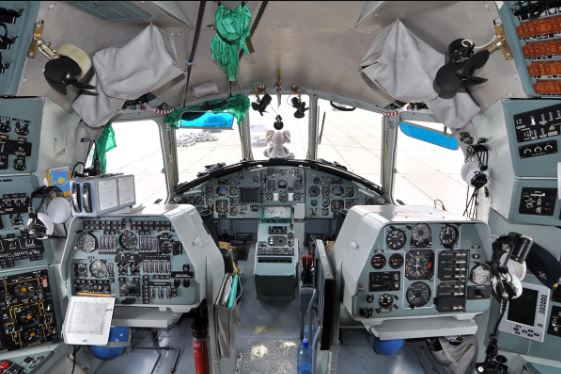Mil Mi-26 Halo Specs, Engine, Cockpit, and Price – Mil Mi-26 (NATO reporting name: Halo) is a twin-engine heavy-lift helicopter designed and manufactured by the Mil Moscow Helicopter Factory, Russia. The Mi-26 is intended for all types of operations, including the role of the military, transportation, evacuation, fire fighting and others. The Mi-26 is capable of carrying up to 82 fully armed troops or up to 20 tons of cargo on board or in an external sling. This is the second largest and most powerful helicopter in the world, and began operating in 1985.
The first helicopter flight took place in December 1977. The first Mi-26 was launched in October 1980. The first prototype helicopter was exhibited at the Paris Air Show 1981. After completing the development of the Mi-26 in 1983, it began operations in 1985. About 276 Mi helicopters -26 currently operating throughout the world.

The Mi-26 helicopter has eight main rotor blades and five electric rotor blades mounted above the center of the fuselage on the hump. The main rotor blades and electric rotors are equipped with an infrared jammer, infrared suppressor, infrared feed dispenser and a color-coded flare system to protect the helicopter from ballistic missiles. Infrared jamers block the transmission of infrared signals and protect the helicopter from infrared missiles.
The helicopter also consists There is a cargo compartment at the rear of the cockpit. The compartment, which is 12 m long, 3.3 m wide and 3.2 m high, can accommodate two combat vehicles each about 1,000 kg each. Two electric cranes on the top rail are used to move loads to the cab. It also offers a closed-circuit television camera to monitor the position of the attached load.
The landing gear helicopter Mi-26 helicopter is a non-retractable three-wheel type with two retractable nose wheels. Hydraulic cranes allow the loading of cargo from different surfaces through the rear door (fuselage) using stairs and sub-stairs. Takeoff weight can be displayed on sensors or electronic devices mounted on the main gear rack on the rear side of the flight engineer seat.

The Mi-26 helicopter is equipped with a Groza 7A813 weather radar, integrated PKV-26-1 flight navigation system, automatic flight control system, Doppler, map display, horizontal situation indicator (HSI), automatic hover system, and global positioning system (GPS) .

The maximum speed of the Mi-26 helicopter is 295 km / h and the cruising speed is 255 km / h. The range and service helicopter ceilings are 1,952 km and 4,600 m respectively, while the suspended ceiling is 1,700 m. The helicopter weighs around 28,200 kg and the maximum take-off weight is 56,000 kg.

The Mi-26A is an advanced version of the Mi-26 and completed its flight test in 1985. The Mi-26A was upgraded with a PNK-90 flight navigation system structured for automatic approach and descent.
Another variant, the Mi-26M is an upgraded version of the Mi-26. This is combined with the flight navigation system, D-127 turboshaft engine, electronic flight instrumentation system and aerodynamic rotor blades for better performance.
The Mi-26T is a commercial cargo or goods transportation version. It was first exhibited at the 1997 Moscow Air Show. The helicopter was then displayed at the Farnborough Air Show held in 2002 after installing sophisticated avionics by Rostvertol.
The Mi-26MS is an upgraded model of the Mi-26T. The variant is a medical evacuation helicopter and consists of an intensive care section for four victims and two medics, an ambulance section for five stretcher patients, three seated victims and two officers, and a laboratory.
The Mi-26NEF-M is another variant of the Mi-26 which is equipped with a search radar under the nose radome. This is an anti-submarine war version, which offers heat exchangers and MAD-drawn housing that is mounted on the road.
The Mi-26P is a passenger transportation version, which can carry 70 to 100 passengers. This variant has airline-type seating, with a center aisle, bathroom, kitchen, and changing rooms near the flight deck.
Another variant, the Mi-26PP, is a radio-relay version with the first flight test completed in 1986. The Mi-26PK originates from the Mi-26P. This is a flying crane helicopter that was introduced in 1997. The Mi-26S is a version of disaster relief combined with a liquid tank and an underbelly spraying apparatus.
The Mi-26TP is a fire helicopter, which can distribute 17,260l of water from a VSU-15 squat bucket. It was first introduced in 1994. Another variant, the Mi-26TS, is an export version of the Mi-26T supplied to Samsung Aerospace Industries, South Korea. The Mi-26TZ is a fuel tanker version, while the Mi-27 is an air posko variant.
The first helicopter flight took place in December 1977. The first Mi-26 was launched in October 1980. The first prototype helicopter was exhibited at the Paris Air Show 1981. After completing the development of the Mi-26 in 1983, it began operations in 1985. About 276 Mi helicopters -26 currently operating throughout the world.

Mil Mi-26 Halo Specs
Mi-26 helicopters are designed to improve flight safety and reliability. This also reduces the flight crew's workload, mission planning time and total operational costs. It was designed to replace the previous Mi-6 and Mi-12 helicopters. The composite material used in the fuselage design reduces the overall weight of the helicopter. The alloy used in airframe construction is 26% lighter than the aluminum alloy previously used in Mi-6 helicopters.The Mi-26 helicopter has eight main rotor blades and five electric rotor blades mounted above the center of the fuselage on the hump. The main rotor blades and electric rotors are equipped with an infrared jammer, infrared suppressor, infrared feed dispenser and a color-coded flare system to protect the helicopter from ballistic missiles. Infrared jamers block the transmission of infrared signals and protect the helicopter from infrared missiles.
The helicopter also consists There is a cargo compartment at the rear of the cockpit. The compartment, which is 12 m long, 3.3 m wide and 3.2 m high, can accommodate two combat vehicles each about 1,000 kg each. Two electric cranes on the top rail are used to move loads to the cab. It also offers a closed-circuit television camera to monitor the position of the attached load.
The landing gear helicopter Mi-26 helicopter is a non-retractable three-wheel type with two retractable nose wheels. Hydraulic cranes allow the loading of cargo from different surfaces through the rear door (fuselage) using stairs and sub-stairs. Takeoff weight can be displayed on sensors or electronic devices mounted on the main gear rack on the rear side of the flight engineer seat.

Mil Mi-26 Halo Cockpit and Avionics
The pressurized cockpit of the Mi-26 helicopter is capable of optimizing visibility and can accommodate five crew members, namely pilots, co-pilots, flight engineers, navigators, and electronic radio operators. The pilot and co-pilot seats are located close to each other on the front side of the cockpit control panel. The seat of the flight engineer and navigator is built on the back side of the pilot's seat.The Mi-26 helicopter is equipped with a Groza 7A813 weather radar, integrated PKV-26-1 flight navigation system, automatic flight control system, Doppler, map display, horizontal situation indicator (HSI), automatic hover system, and global positioning system (GPS) .

Mil Mi-26 Halo Engine
The Mi-26 helicopter is powered by two Lotarev D-136 turboshaft engines. Each engine is capable of producing 8,380 kW of power. The synchronization of output between the two engines maintains a constant rpm rotor. The second engine's output will be increased to maximum power when the first engine fails to complete the task efficiently. Each engine compartment is manufactured with titanium to protect it from fire. The maximum internal fuel capacity of each tank is 12,000 l.The maximum speed of the Mi-26 helicopter is 295 km / h and the cruising speed is 255 km / h. The range and service helicopter ceilings are 1,952 km and 4,600 m respectively, while the suspended ceiling is 1,700 m. The helicopter weighs around 28,200 kg and the maximum take-off weight is 56,000 kg.

Mil Mi-26 Halo Variants
The Mi-26 helicopter has 13 variants, which include the Mi-26A, Mi-26M, Mi-26MS, Mi-26NEF-M, Mi-26P, Mi-26PP, Mi-26PK, Mi-26S, Mi-26T, Mi- 26T, Mi-26TP, Mi-26TS, Mi-26TZ and Mi-27.The Mi-26A is an advanced version of the Mi-26 and completed its flight test in 1985. The Mi-26A was upgraded with a PNK-90 flight navigation system structured for automatic approach and descent.
Another variant, the Mi-26M is an upgraded version of the Mi-26. This is combined with the flight navigation system, D-127 turboshaft engine, electronic flight instrumentation system and aerodynamic rotor blades for better performance.
The Mi-26T is a commercial cargo or goods transportation version. It was first exhibited at the 1997 Moscow Air Show. The helicopter was then displayed at the Farnborough Air Show held in 2002 after installing sophisticated avionics by Rostvertol.
The Mi-26MS is an upgraded model of the Mi-26T. The variant is a medical evacuation helicopter and consists of an intensive care section for four victims and two medics, an ambulance section for five stretcher patients, three seated victims and two officers, and a laboratory.
The Mi-26NEF-M is another variant of the Mi-26 which is equipped with a search radar under the nose radome. This is an anti-submarine war version, which offers heat exchangers and MAD-drawn housing that is mounted on the road.
The Mi-26P is a passenger transportation version, which can carry 70 to 100 passengers. This variant has airline-type seating, with a center aisle, bathroom, kitchen, and changing rooms near the flight deck.
Another variant, the Mi-26PP, is a radio-relay version with the first flight test completed in 1986. The Mi-26PK originates from the Mi-26P. This is a flying crane helicopter that was introduced in 1997. The Mi-26S is a version of disaster relief combined with a liquid tank and an underbelly spraying apparatus.
The Mi-26TP is a fire helicopter, which can distribute 17,260l of water from a VSU-15 squat bucket. It was first introduced in 1994. Another variant, the Mi-26TS, is an export version of the Mi-26T supplied to Samsung Aerospace Industries, South Korea. The Mi-26TZ is a fuel tanker version, while the Mi-27 is an air posko variant.
Mil Mi-26 Halo Price and Orders
The price of the latest Mil Mi-26 helicopter is around US $ 25 Million. The Indian Air Force (IAF) ordered six Mi-26 helicopters, two of which, valued at INR180 million ($ 3.86 million), were delivered in June 1986. The third and fourth were sent to the IAF in February 1989 at a cost of INR220. 7 million ($ 4.73 million). However, the remaining two were canceled due to reduced utilization of the aircraft. IAF has also bought 12 machines.
Mil Mi-26 Halo Specs, Engine, Cockpit, and Price
 Reviewed by Admin
on
01:00
Rating:
Reviewed by Admin
on
01:00
Rating:
 Reviewed by Admin
on
01:00
Rating:
Reviewed by Admin
on
01:00
Rating:






No comments: